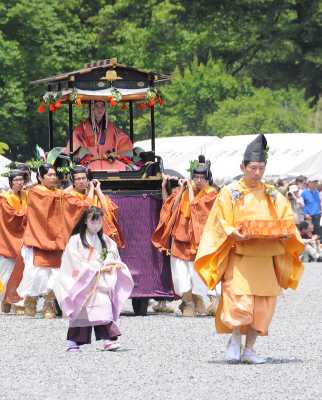Last Wednesday, I visited the Aoi matsuri. It takes place every year on May 15th, and is thus the first of the three main matsuri (festivals) in Kyoto (the others are the Gion festival in July and the Jidai festival in October).
Aoi matsuri dates back to the 6th century, when the emperor sent an emissary to the shrines to perform rituals to end a famine caused by ceaseless rains. The name derives from the hollyhock (aoi) leaves all participants wear on their garments, but officially it is named Kamo matsuri, because it involves rituals at two shrines in Kyoto.

Essentially, Aoi matsuri is a procession of more than 500 people – all dressed in elaborate Heian-era costumes – 35 horses and two large ox carts, which starts at the imperial palace, stops at Shimagamo shrine for the first set of rituals (that take about two hours), and then moves on to Kamigamo shrine for the final rituals.

Among the 500 people participating in the procession, there are two main figures: Firstly, the imperial messenger, who leads the procession on horseback and is responsible for presenting the emperor’s offerings at the shrines. Secondly, the Saio-dai, a young unmarried woman from Kyoto (in former days a close relative of the reigning emperor) who dedicates herself to Shimogamo shrine. She has to undergo a purification ritual before the festival, and she is the eye catcher of the procession, as she wears the most elaborate of all garments (a so called 12-layer-robe junihitoe, which essentially consists of 12 kimonos word on top of each other) and is carried along in a palanquin. The procession starts at 10:30 at the Imperial Palace and arrives at Kamigamo shrine at around 15:30, so the festival takes all day.

I went to the palace about an hour before the start of the procession, and I was lucky to secure a spot in the second row of spectators. It was a perfect day for the spectacle, with bright blue sky, but not too hot weather. Once the procession started, it moved relatively fast, the whole thing had passed me within one hour. It was fascinating to watch…

As I said, there were about 500 participants; men either on foot or on horseback, dressed as warriors, courtiers, priests, acting as attendants or carrying various types of offerings to the shrines or simply responsibility; women, all dressed in multiple layered kimono, some underneath large umbrellas, others on horseback, some on foot, as attendants to the Saio-Dai; and a number of young girls, also representing attendants of the Saio-Dai. Then there were two large ox carts, with man-high, creaking, gold-leafed wooden wheels, pulled by an ox and pushed by maybe 10 men. The whole procession was an explosion of colour, everything was heavily decorated, there were flowers and the hollyhock leaves… it was beautiful.

After the procession had passed, the crowd dispersed surprisingly quickly. Although I had not intended it, I went along to Shimogamo shrine after all. Unfortunately I came to late, so I did not see any of the offerings done at the shrine itself. I was, however, lucky enough not to miss the big thing: the horse race. At Shimogamo shrine, there is a short racetrack, where five horses competed in three races. They rode consecutively and were timed individually – unfortunately I had no way of finding out the winner. Again, both riders and horses wore Heian-style attire, and it did not seem easy to stay in the saddle at full speed… Once again I was lucky to get a good spot there as well to take some pictures of the action.

However, after the race I decided not to go further to Kamigamo shrine, as it is quite far outside, and also as I would again not have been able to arrive on time to secure a good spot from which to see the offerings. Now I know that there is apparently some archery – from horseback – involved in those rituals… Oh well, next year.
In any case, it was an exciting and beautiful day (I have the sunburn to prove it) and I’m already looking forward to the next matsuri.
